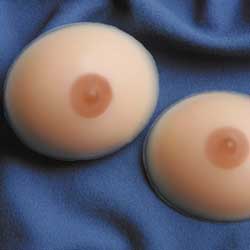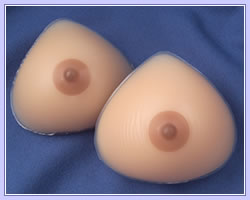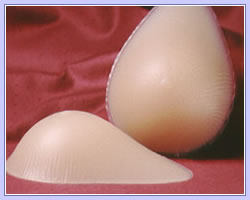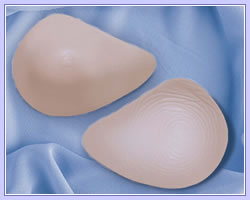|
|
Were
you looking for my pics and videos? Click here:
Breasts: A How-To Guide,
Part 4
12/09/07
If you've read the other breastform sections, you'll
be familiar with this intro paragraph, but here goes. At this
point I'm assuming you've read 4 things already, or at least have
some prior knowledge of them . . . first is an overview of breast
and bra sizes and shapes from my clothes
section. Second is Breasts 101 which
covers reasons for using breastform alternatives, and the basic
method of stuffing, third is Breasts 102
which covers sewing a basic re-usable breastform, and fourth is
Breasts 103 which covers homemade "silicone"
breastform substitutes. Or maybe you just came straight here because
you have a huge wallet and don't want to bother with the homemade
stuff? That's fine, but I'd still advise that you play around
with some sort of homemade form (even just stuffing) to at least
get an idea of what size and shape you're looking for.
Ok, so you want to buy breastforms, hmm? Well the
first thing to figure out is an appropriate size. Oh, and be aware
that the larger the form you want, the more expensive. So not
only are smaller forms usually MUCH more realistic, but they are
also usually cheaper! If you're not sure what size you want, go
re-read the bra section under clothes.
There is a really good summary there at the end of the section.
But to re-cap, shoot for a B-cup breast to be "average",
and don't forget that the size breast form you need to be B-cup
changes based on your band size. I'm going to guess that most
crossdressers will ignore my advice and go for a C-cup, and there's
nothing wrong with that. But I really do not recommend forms that
are D-sized and larger unless you really just want huge tits and
don't care what anyone else says.
If you do go for large breast forms (D-cup or bigger),
they will frequently be a bit saggy. After all the original intent
of breast forms was to replace breasts that were removed from
cancer patients, and most cancer patients are older and gravity
is starting to take effect if they have large breasts. That means
. . . you either need a REALLY good bra, which will likely squish
the breastform and cause wrinkles in it. No permanent damage or
anything, but it doesn't really look pretty. Or your other option
is to find breasts made specifically for crossdressers that are
advertised as "perky" or "young" or something
of the sort. Add some extra cash for this option usually. And
just because they say perky doesn't mean they will stay on your
chest and not sag . . . you're really going to have to glue these
suckers on solid, and you'll probably still need a strong bra
to keep them from causing your SKIN to sag and thus the breast
in turn will look less than perky.
Ok, enough on size, on to shape. Again, go re-read
the bra section under clothes if
you don't remember what shapes are available. As a reminder though,
here are some of the more common shapes:
 |
 |
 |
 |
Round |
Triangular |
Teardrop |
Asymmetrical |
Now what I didn't mention before is that triangular
forms are a little saggy too by their nature - one of the points
of the triangle goes up, which means two of the points are on
the lower edge of the form resulting in most of the breast mass
being at the bottom of the form. Don't worry though, that's the
way breast tissue really works. Teardrop forms can be worn in
2 different directions. If you have the point of the teardrop
up, it may be a little saggy, but actually looks very realistic
if you want to go bra-less. The other option is to wrap the point
of the form around under your arm, which makes for a very perky
breast. It's somewhat unrealistic though because then the nipple
points slightly outward away from the center of your body. I'm
still a huge fan of the asymmetrical breastform - it creates a
very realistic but perky breast. The little point goes up, creating
the impression of weight (sort of like sag, but only enough to
appear real), and the large point wraps under your arm, filling
in that oh-so-important breast tissue that most people forget
even exists.
One last note on shape . . . you've probably met
girls who say they've got big C or D tits, and you look at them
and wonder how they hide them so well. Or maybe you see a girl
with amazing boobs who claims to "only" be a C-cup.
That's because (among other things, like how much underlying muscle,
how firm the connective tissue, how dense the breast is, etc)
there are two ways to fill the volume of a cup - projection (outwards
from the body) and spread (think the "width" of the
breast). Projection makes for breasts that look really good, have
great cleavage, etc. But later in life these will also be the
breasts that hang straight down. Spread makes the breast appear
more uniform with the chest wall, and causes breasts to disappear
when a girl lays on her back. When shopping for breast forms you're
not likely to have options about projection vs spread, though
some stores will advertise that their forms have "great projection".
There does not seem to be a standard measurement for this, but
in my experience most forms are made with a fairly standard ratio
to fit the "average" person. If you DO have a choice,
remember that you want a balance of projection and spread - spread
is what will connect the form to your body and keep it in place.
Projection will create the appearance you're looking for.
Ok, so you know what size form you want, and you
know what shape you want . . . now it's on to materials! "But
aren't they just all made of silicone?" No! Silicone is the
best known and most common material to be sure. And for good reason
- it has great texture, weight, and elasticity, just like a real
breast. It's also uber-expensive, fragile, sensitive to chemicals,
and the for large breasts it can break under its own weight. It's
worth a little more discussion though so you know the details
if you're looking into silicone forms.
Silicone . . . the most realistic form you can get.
The density is about the same as fat (ie breast tissue), and the
elastic properties are also amazingly similar - it "bounces".
The problem with this great density is that you are trying to
attach the form to your skin, which is also amazingly stretchy,
and the form has to be able to support it's own weight. In a real
breast everything is held inside a nicely resilliant package and
attached to the rest of the body with some super connective tissue
- it's not going anywhere in the short term. So large silicone
forms will sag the farther they project from the body, and the
more total weight in the form the more they will cause your own
skin to sag with them. Silicone comes in a lot of varieties .
. . and breastforms are made of 2. The "filling" of
the form is different from the "skin". The filling has
the right properties to simulate fat, but it doesn't hold itself
together very well. So a skin layer is added to hold the form
together, much like a woman's skin holds the breast tissue in.
This skin layer, however, doesn't feel very much like real skin,
so manufacturers try to keep it as thin as possible. A thicker
skin of course is more resistant to damage and can support more
total weight in the form without sagging, but you sacrifice some
of the realistic feel and bounce. The skin is also important because
if it is punctured or ruptured, your form is ruined. And because
the skin is made thin for the sake of realism, it's easy to damage.
So keep your forms away from sharp objects, and never sleep in
silicone forms or lay directly on them! In addition, don't use
any products on or around your breast forms that aren't specifically
breast form safe. This means tapes and adhesives, as well as lotions,
lubricants, cleaning products, etc. Mild soap (ie hand soap) is
fine, but otherwise keep chemicals away!
Whipped silicone is a fairly new material used for
breast forms. It has all the same properties of regular silicone
except that there are tiny little air bubbles in it, so it's more
foamy than dense. It's used for larger forms so they don't sag,
and so they are easier to wear (don't weigh you down, cause back
problems, etc). They also don't feel quite the same, and don't
bounce quite the same. Of course, if you have DDD forms, you'll
probably be thankful of it. Don't bother with whipped for "normal"
sized forms though, as it will only ruin some of the realism.
Swim forms are a different material . . . I think
they are a type of silicone, but not 100% sure. Anyway, they are
sufficiently chemically resistant to go into chlorine water (don't
try this with your regular silicone forms) and are also lighter
weight. Which means less realistic, but more comfortable for sports,
etc. Unless you literally plan on going swimming though, you probably
won't be interested in swim forms.
Foam forms. These are great for creating the appearance
of breasts without some of the disadvantages of silicone forms.
They do not feel like breasts though, and they do not bounce.
They are litterally made out of squishy foam like the egg-crate
material you can buy for a matress pad, etc. Foam forms are less
expensive and much more durable than silicone though - you can
sleep in them, lay on them, pack them in suitcases, etc. As long
as all you need is to LOOK like you have breasts, this is the
way to go. If you want to FEEL like you have breasts (including
the way they feel on you, not just the way they feel when you
squeeze them) you will need to go with silicone. There is really
no substitute. Foam is also more chemical resistant and should
hold up to most stuff you might put on your body. Of course, even
though they're less expensive than silicone, there's still not
cheap. So I still wouldn't recommend wearing too much lotion or
lathering them up with baby oil or lube or anything.
Last topic is breastform adhesive. No, you do not
NEED adhesive - using a bra can work just fine. You will need
a full coverage bra if you're not using adhesive, so that the
top of your form doesn't flop away from your chest, but you will
probably want a full coverage bra anyway because breast forms
never match your skin tone and will always look fake if they're
not covered (anyone know a trick that I don't for blending a form
to your chest?). Another option is a bra with a pocket designed
for holding breastforms, and in this case you cannot use adhesive.
If you want to go bra-less, or need some extra security (don't
have a good bra, or will be moving around a lot), you will want
to look into breastform adhesive. Sometimes this is sold as medical
adhesive, but not all medical adhesives are safe for silicone.
Your best bet is to buy stuff specifically formulated to be safe
for breastforms, but you can also look for a medical adhesive
that says "safe for breastforms" or "silicone compatible".
Along with your adhesive, you will want adhesive remover, otherwise
you will get a nasty dirty film on the back of your forms eventually
where dirt and oil from your skin adhere to the tape. And speaking
of tape . . . it is possible to use 3M double sided tape as an
adhesive, but I've yet to figure out a good way to get it back
off. Also rather painful to remove from your chest, but bearable
(not sure how it compares to other adhesives). Anyway, it's left
a film on the back of my forms, so I stopped using it. But it
never damaged the silicone at least. One other "must do"
with adhesives . . . shave your chest! otherwise you will not
be happy when it's time to remove the forms.
To apply adhesive, just press it down around the
edges of the form, trying to make as continuous of a line as you
can, as close to the edge of the outline as you can get it. Holding
down the edges of the form is the most important part, as this
is the area you don't want to flap up. And often the backs of
breast forms are concave, so the center of the form may not even
touch your chest anyway. It's also helpful sometimes to line up
the form on your chest BEFORE applying the adhesive, especially
the first few times. The best way to do this is to get a bra that
leaves the top of the form exposed (the kind I keep telling you
not to try and use with forms, I know). Put the bra on and fit
the forms in it, lining everything up the way you want them to
sit on your chest. Then get some eyeliner or lipliner and gently
trace the outline of the form, or a piece of the form, on your
chest. Now when you put the adhesive on, you can just stick the
form right to your chest lined up with the outline. Because breastform
adhesive is STICKY, and if you don't line it up right the first
time, too bad - there is no slight adjusting after it's on, you
have to do it all over again. Also, it's very easy to notice if
someone's breasts are lopsided, so be very careful that your two
sides match. You'd be surprised at how little of a mismatch will
make you look funny!
|